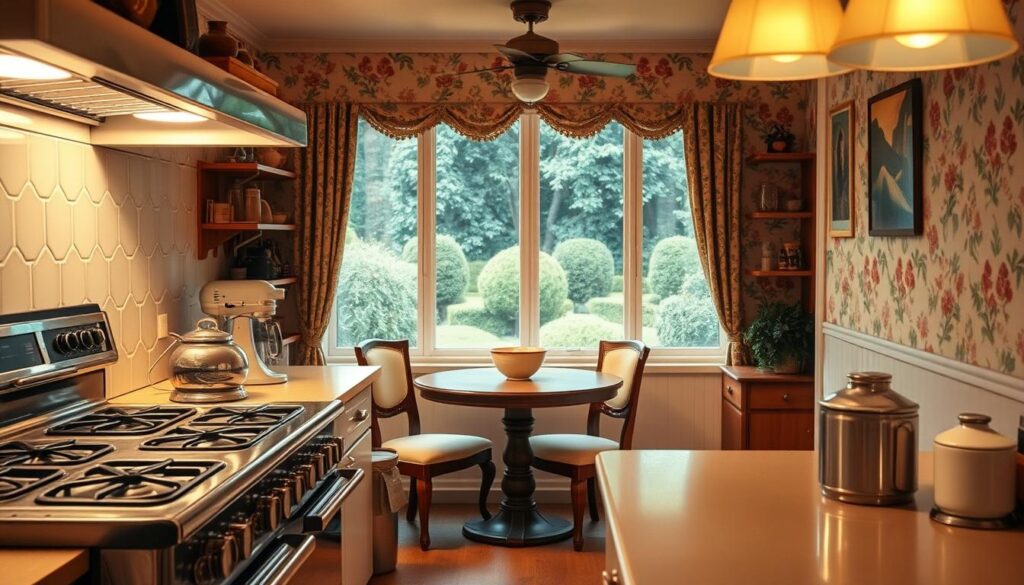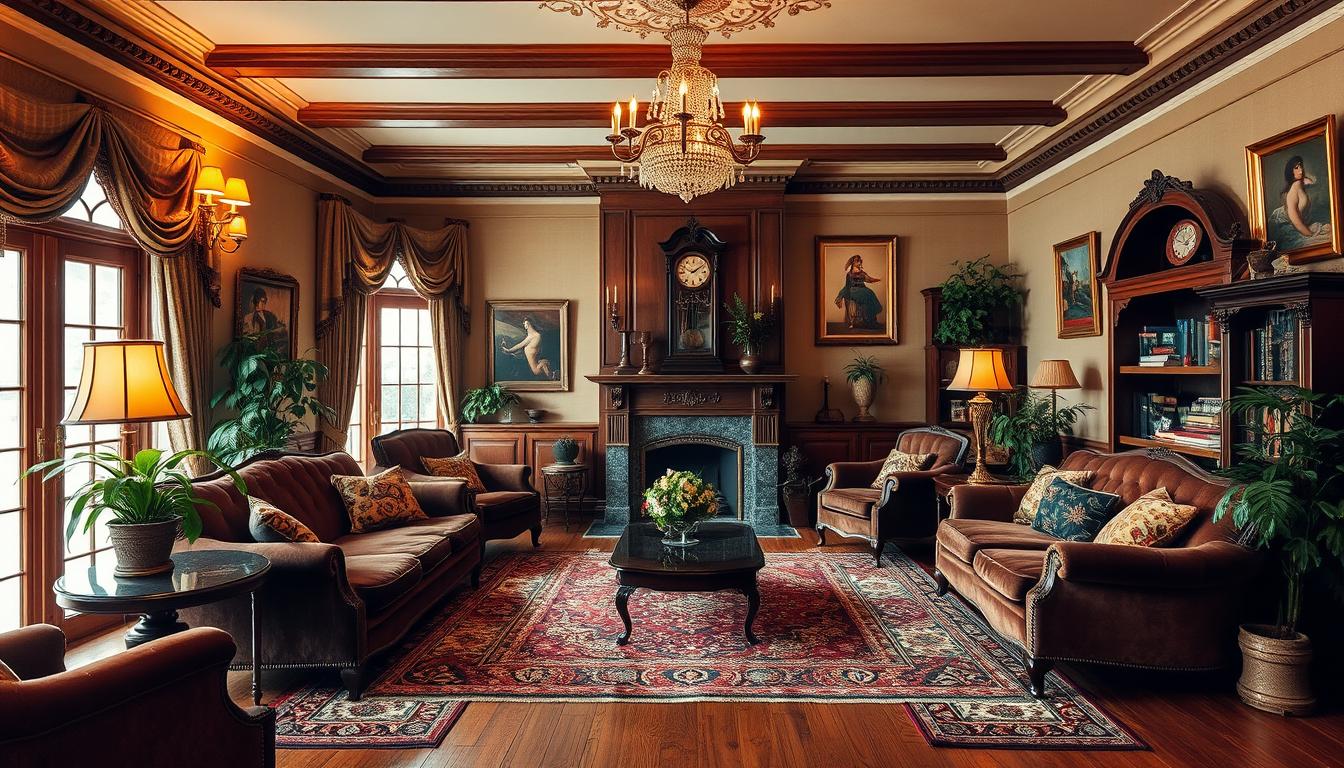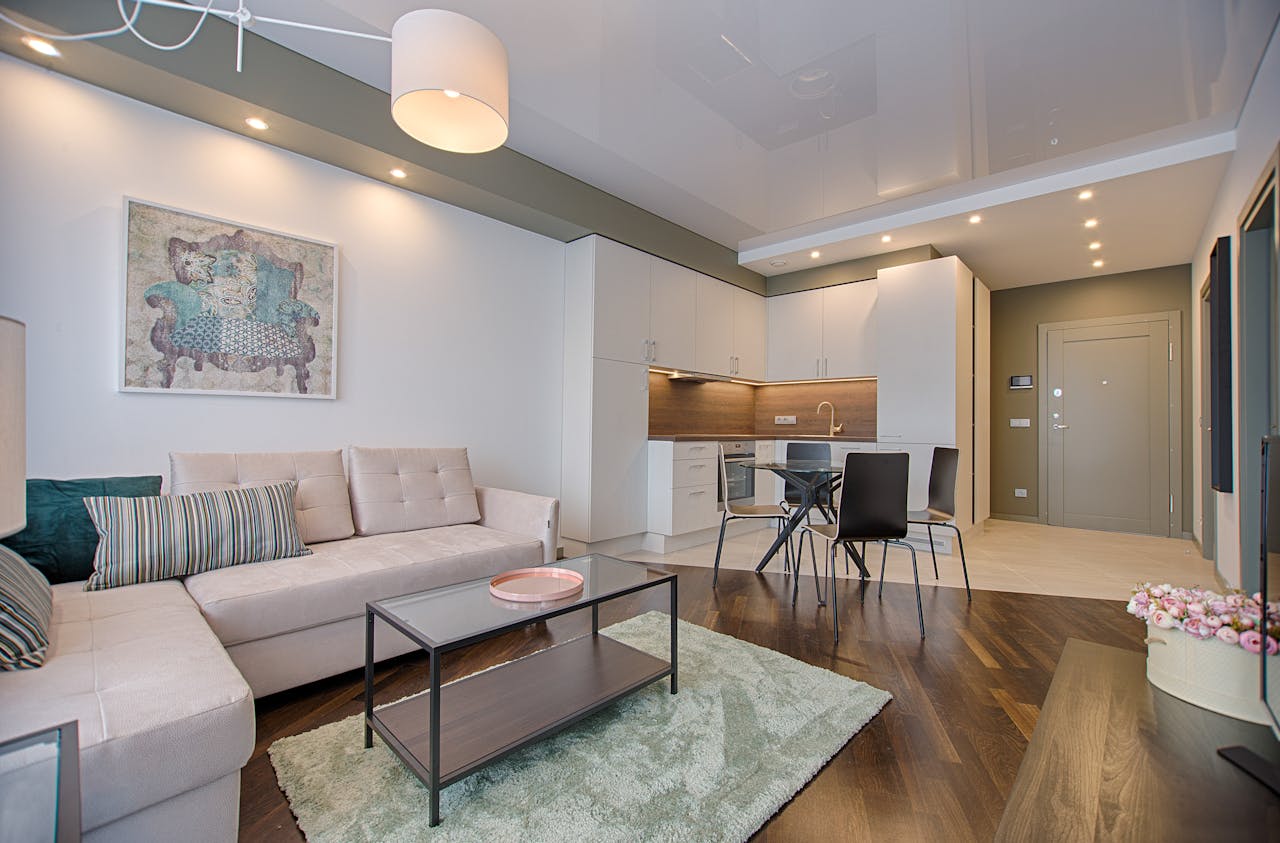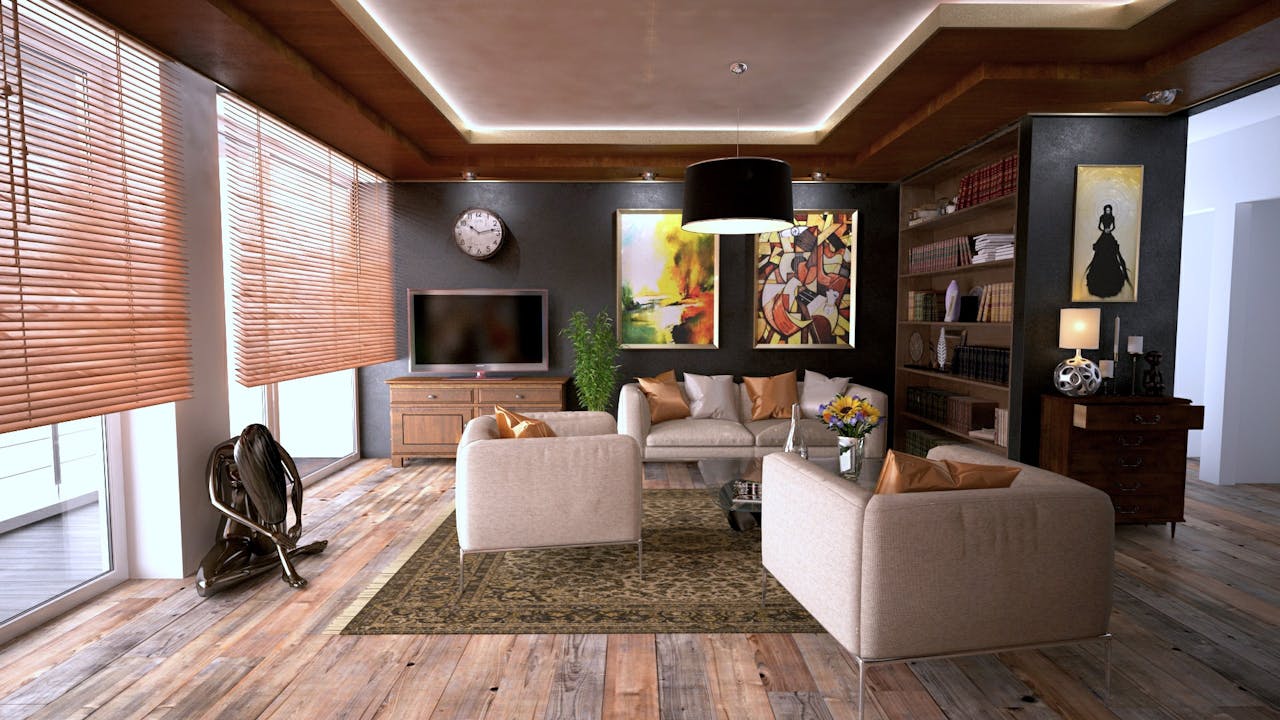The 1940s interior design style is often called ‘vintage’ and ‘nostalgic’. It brings a sense of warmth and comfort. During this time, retro design elements were common in many homes. They made the homes cozy and welcoming.
Today, we can still see the 1940s’ influence in modern interior design. Many designers add vintage touches to their work. The 1940s home decor is loved for its ability to bring a sense of nostalgia and warmth. It’s perfect for creating a cozy family home atmosphere.
Key Takeaways
- The 1940s interior design style is characterized by its vintage and nostalgic appeal.
- Retro design elements were a staple in many family homes during this era.
- The timeless appeal of 1940s home decor lies in its ability to create a sense of nostalgia and warmth.
- Vintage home decor continues to influence modern interior design.
- The use of vintage elements can add a unique touch to any room.
Understanding the 1940s Design Aesthetic
The 1940s design was a mix of simplicity, functionality, and a patriotic vibe. This era’s design was shaped by the war, showing the values and challenges of that time.
Key Characteristics of 1940s Interiors
The 1940s interiors were all about simplicity and functionality. With men away at war, women took on new roles. Homes became more practical, with furniture that could do more than one thing and less clutter.
Popular Color Palettes of the Era
The 1940s colors were patriotic and sunny, with lots of red, white, and blue. Muted greens and yellows also made homes feel warm and cozy.
In the 1940s, resourcefulness and thriftiness were key. Home decor showed this, with a focus on using what you had and adding bold colors and patterns for a lively feel.
Looking closer at the 1940s design, we see how the war influenced it. The lack of materials made homes durable and practical.
Furniture Styles That Defined the Decade
The 1940s brought big changes in furniture design. Designers like Eero Saarinen introduced new shapes and uses. They mixed old skills with new materials, starting the modern furniture trend.
Iconic Pieces from the 1940s
Eero Saarinen’s designs, like the pedestal table and Tulip chair, showed the decade’s love for “organic furniture.” These pieces brought new shapes and changed how we use furniture.
Other famous items from the 1940s include sleek sofas and chairs with bold prints. They were made to look good and work well, showing the era’s love for modern and simple designs.
The Rise of Mid-Century Modern Furniture
The 1940s kicked off the mid-century modern movement. It was all about clean lines, organic shapes, and being useful. Designers aimed to make furniture that was both stunning and easy to use for everyday people.
Mid-century modern furniture used new materials like plywood and aluminum. It was made to fit any room and to be simple and useful. This style matched the post-war values of being practical and efficient.
Popular Fabrics and Textiles
The 1940s fabric choices still inspire vintage home decor today. They bring a timeless charm and style. Fabrics and textiles were key in setting the look of home interiors back then.
Fabrics from the 1940s featured classic patterns and prints. These added warmth and personality to rooms. They also showed the cultural and social trends of the time.
Classic Patterns and Prints
Classic patterns like florals, stripes, and geometric shapes were big in 1940s textiles. These patterns were used in many ways, from furniture to bedding.
- Florals were especially loved, with bold, colorful blooms.
- Stripes and geometric patterns brought a modern feel to traditional designs.
- Patriotic motifs were also common, showing the era’s global conflicts.
The Use of Bold Colors in Upholstery
Bold colors were a big part of 1940s interior design. Bright colors like red, blue, and yellow made furniture pop.
Some key points about bold color use include:
- Accent pieces, like throw pillows and armchairs, were often in bold, contrasting colors.
- Upholstery fabrics often mixed bold patterns with solid colors.
- Bold colors helped make living spaces warm and cozy.
Using these classic patterns, prints, and bold colors lets homeowners bring nostalgic home styling into their homes. It creates a unique and welcoming space.
The Role of Artwork in 1940s Homes
In the 1940s, artwork in homes was a window to the era’s soul. The decade was filled with cultural and historical events that shaped home decor. Artwork reflected the mood of society, with many art movements becoming popular.
The 1940s saw the rise of Surrealism and Abstract Art. Artists like Salvador Dali and Jackson Pollock became famous. Their work added a unique touch to home decor, reflecting the era’s culture.
Famous Artists and Their Influence
Famous artists of the 1940s greatly influenced home decor. Salvador Dali’s surrealist works and Jackson Pollock’s abstract pieces added sophistication and creativity. Their art made homes more interesting.
These artists’ influence is seen in popular home decor. For example, surrealist art added elegance and intrigue to rooms.
Wall Decor Trends of the Period
Wall decor in 1940s homes mixed traditional and modern styles. People used framed artwork, mirrors, and wall shelves to create a beautiful atmosphere.
Some trends included:
- Using framed prints of famous artworks
- Incorporating mirrors to add depth
- Displaying collectibles on wall shelves
| Wall Decor Element | Description | Impact on Home Decor |
|---|---|---|
| Framed Artwork | Framed prints of famous artworks or original pieces | Added elegance and sophistication |
| Mirrors | Large and ornate mirrors | Created the illusion of larger spaces |
| Wall Shelves | Shelves used to display collectibles and decorative items | Added a personal touch to rooms |
The 1940s’ artwork and wall decor trends still influence home decor today. Many incorporate retro design into their homes. Understanding the 1940s’ aesthetic helps us appreciate its lasting impact on interior design.
Lighting Choices in 1940s Spaces
In the 1940s, lighting fixtures became a key part of home decor. They showed the era’s style and values. The decade mixed old and new lighting, thanks to new tech and materials.
Types of Light Fixtures
Many light fixtures were popular in the 1940s, including:
- Table lamps with sculptural shapes
- Floor lamps with adjustable arms
- Pendant lights with glass shades
- Chandeliers with a mix of metallic and glass elements
These lights did more than just light up a room. They added to the room’s look. New materials like aluminum and Bakelite led to sleeker designs.
Innovations in Home Lighting Design
The 1940s saw big changes in home lighting, thanks to tech and manufacturing advances. Fluorescent lighting became popular, offering a better choice than old bulbs.
| Lighting Type | Characteristics | Notable Features |
|---|---|---|
| Fluorescent Lighting | Energy-efficient, longer lifespan | Tubular shape, often used in kitchens and bathrooms |
| Sculptural Table Lamps | Artistic designs, varied materials | Often featured unique shapes and bases |
| Pendant Lights | Versatile, can be used in various rooms | Glass shades, sometimes with metallic accents |
As mid-century modern design started, lights got more advanced. They had clean lines, less decoration, and focused on being useful.
“Good lighting is not just about visibility; it’s about creating ambiance and enhancing the beauty of a space.” – This idea was key in the 1940s. Homeowners saw how lighting could make a space look better.
The lighting of 1940s homes was all about mixing usefulness with style. This mix set the stage for later trends in 1940s home interiors.
Kitchen Design Trends from the 1940s
The 1940s brought big changes to kitchen design, thanks to wartime needs and new tech. Homes became more modern, and kitchens got more practical and efficient. This showed the era’s focus on being useful.

Layout and Functionality
Kitchens in the 1940s were all about being useful. They had layouts that made things easier. The “work triangle” idea, with sink, stove, and fridge in a triangle, was key. It made moving around and cooking simpler.
Built-in cabinets and countertops became common too. They made kitchens look better and work better. These features added to the kitchen’s beauty and usefulness.
Iconic Appliances of the Era
The 1940s saw the rise of famous appliances that changed kitchens. Brands like General Electric and Westinghouse led the way. They offered cool stuff like refrigerators and stoves that showed off the era’s tech.
- Refrigerators: New features like automatic defrosting made fridges better and easier to use.
- Stoves: Stoves with better controls and cool designs, like the “Magic Chef” stove, were all the rage. They gave cooks more options.
These appliances didn’t just show off the era’s tech. They also changed how people cooked and what kitchens looked like for years to come.
Living Room Essentials from the 1940s
Stepping into a 1940s living room feels like stepping into a cozy space. These rooms were made to be warm and inviting. They were designed for family bonding and relaxation.
Cozy Arrangements for Family Gatherings
The 1940s living room was perfect for family gatherings. Plush sofas and armchairs were set up around a coffee table. This made a cozy spot for everyone.
Warm lighting and rich textiles made the room even more welcoming. Families would gather around the radio or fireplace. They’d share stories and enjoy each other’s company.
Signature Decor Items
The 1940s living room had unique decor items. Wall clocks, vintage artwork, and decorative vases added elegance. These items showed off the family’s style.
- Vintage rugs and throw blankets in rich patterns and colors
- Classic furniture pieces, such as wingback chairs and ottomans
- Decorative accents, like vintage figurines and collectibles
These elements made the living room warm and welcoming. It was the heart of the home. By adding these nostalgic home styling elements, you can bring 1940s charm to your home today.
Outdoor Spaces and Gardening in the 1940s
When we look at the 1940s outdoor spaces, we see a mix of function and beauty. This era made outdoor living a big part of home life. It showed the design style of the time.
The mid-century modern movement shaped outdoor designs. It focused on simplicity, clean lines, and blending with nature. Gardens were not just pretty; they were also useful. Many people grew vegetables and fruits in their yards.

Gardening and Landscaping Styles
In the 1940s, there were many landscaping styles. Some were formal and symmetrical, like European gardens. Others were more relaxed and natural. Retro design elements, like geometric patterns and bold flowers, were also common.
- Formal gardens with neatly trimmed hedges and symmetrical flower beds
- Naturalistic gardens that mimicked the surrounding landscape
- Gardens featuring native plants and wildflowers
These styles showed what homeowners liked and what was practical. For example, victory gardens were important during World War II.
Outdoor Furniture Choices
Outdoor furniture in the 1940s was tough and simple. It was made from materials like wrought iron, wood, and canvas. The furniture was meant to last and withstand the weather. It also had vintage home decor touches like detailed metalwork and classic designs.
Some popular outdoor furniture pieces were:
- Wrought iron benches and chairs
- Wooden garden benches and Adirondack chairs
- Canvas sling chairs and hammocks
These pieces not only looked good but also encouraged spending time outside.
How to Incorporate 1940s Style Today
To add 1940s charm to your home, mix vintage pieces with modern ones. This blend creates a unique, timeless look.
Blending Vintage with Modern
Begin by adding historical touches like dark wood furniture or hand-painted art. Then, pair these with today’s furniture and decor. This contrast is striking. For ideas, check out Retro Renovation for authentic 1940s decor inspiration.
Creating a Timeless Look
For a timeless feel, aim for simple, clean interiors and bold color contrasts. Use rich, primary colors and jewel tones to add depth. This balance makes your home both beautiful and functional, honoring 1940s style.



